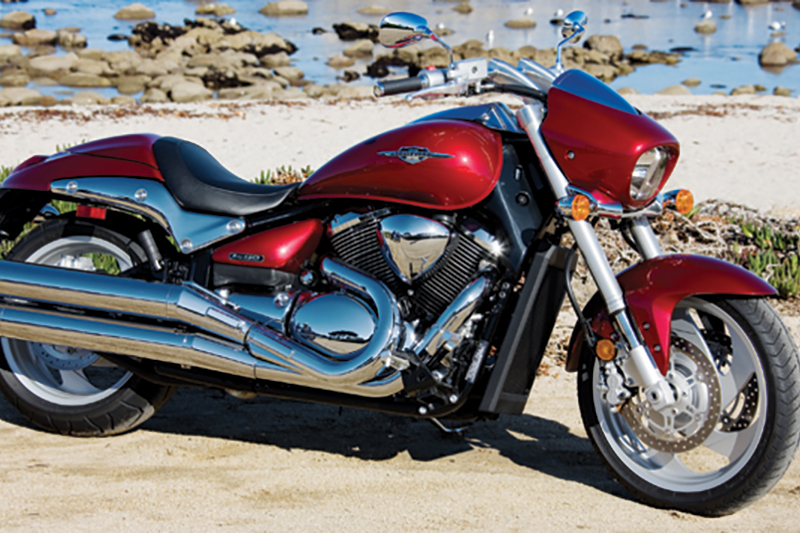2009 Suzuki Boulevard M90

Road Test Review
The other day I looked at my bike’s tires after a long and briskly paced street ride and was surprised at how narrow the bands of virgin rubber, sometimes called “chicken strips,” on the edges were. Not because I was riding on unfamiliar roads with a group of local lunatics on sportbikes; been there, done that. No, I was surprised because these tires were mounted on a 728-pound Suzuki Boulevard M90 cruiser.
I can imagine your eyes rolling in their sockets-so this is what happens when these hotshot California moto-journos get a hold of a cruiser. They flog it and then bash the bike when it doesn’t perform like a 450-pound superbike. Don’t they know the whole point of having a cruiser is to take it easy, enjoy the road?
Somebody needs to tell that to the engineers at Suzuki, because they didn’t get the memo. What they wanted was a middleweight cruiser to fit in the Boulevard lineup between the 805cc M50 and 1,783cc (and $13,099) M109R to sell to “customers longing for the M109R’s styling but who don’t need 1800-class performance,” according to the M90’s Chief Engineer Toshikazu Yamaoka. Easy, right? Just take the existing Boulevard C90, slap on some sportier-looking bodywork and maybe add a male-slider fork…and voila, middleweight muscle cruiser. The problem is Suzuki knows “sporty” means more than looks.
So the Suzuki Boulevard M90 is a ground-up design, and the new ride shares few components with the more sedate C90. The 52-degree motor has the same 96mm by 101mm bore-and-stroke figures, but engine designer Kenta Suzuki (no relation) usually works on sportbikes, so the powerplant got liquid cooling, four-valve heads (with 9.5:1 compression), low-friction SCEM cylinder linings and forged aluminum slipper pistons. Even the 52-degree V-angle is different from the C90’s 45, and the dual 42mm throttle bodies use high-speed digital engine management and Suzuki’s Dual Throttle Valve system to deliver optimal fueling at different rpm. But it isn’t all Ricky Racer; the crankpins are offset for that cruiser lump-dee-dump feel, and big heavy flywheels and tuning designed to deliver peak torque at 2,600 rpm make sure this big beefy engine is appropriate for its mission. Even the wide-ratio five-speed gearbox gets a friction damper between second gear and the driveshaft to keep shifting smooth.
A new motor deserves a new chassis, and like the powerplant, it balances cruiser style with performance features a sportbike guy would appreciate. The steel-tube frame cuts 10mm off the C90’s 66.9-inch wheelbase but keeps the driveshaft that’s almost universal among the Boulevard cruiser lineup. The nonadjustable 43mm fork is a cartridge unit that offers 5.1 inches of travel, and the concealed rear shock (adjustable for preload) works through a linkage to offer up 4.3 inches of rear-wheel swing. New cast wheels with specially designed radial Bridgestones have a sporty look, and the fat 200mm rear tire gives the M90 the widest meat in its class. Braking is handled by dual 290mm brake discs in front with two-piston sliding-pin calipers. The rear brake is a 275mm disc with a fixed two-piston caliper.
It’s not just about handling and braking, so nods were made to cruiser niceties. The chassis design puts the center of gravity nice and low for better low-speed handling and so it’s easy to get the heavy bike off the sidestand. The engine is rubber-mounted at three points in the frame, and the wide, well-padded seat is a manageable 28.2 inches off the deck. There’s no tachometer (something a power cruiser needs), but the instruments are easy to read, and include a clock and dual tripmeters.
For the styling, Suzuki showed prototype drawings to focus groups of U.S. riders all through the design process. The resulting bodywork carries on the theme of “flowing lines” Suzuki wanted, a nine-tenths-scale replica of the bigger M109R. For a cleaner look, designers even concealed the rear-brake master cylinder and seat-latch key and provide the buyer with a sculpted solo seat cowl to replace the passenger seat when the rider is in lone-wolf mode.
Cruisers are more about show than go, rolling concessions to form over function. But not the M90. Hearing a number like “728” getting thrown around for wet weight made me worry about getting the big red bike off its sidestand; I shouldn’t have worried. I also discovered a decent riding position, with the bars at a comfortable level and the ground an easy reach for my 30-inch inseam. The footpegs were a little too far forward for my tastes; they look cool out there, but holding your legs so far out in front of you gets old quickly. The seat is comfortable and the adjustable brake lever is a nice touch. The engine starts up easily and settles into a loping idle with all the requisite cruiser rumbles and growls, with a deep bass note from the musically tuned mufflers.
The bike is easy to ride at low speeds, as a cruiser should be. The clutch lever has a light pull (even though the nonadjustable lever may be too big for smaller hands), and the five-speed transmission is smooth, but with a solid, thunking feel. That low CG and wide bars make the bike easy to maneuver at parking-lot speeds, although the fuel injection is a tad abrupt at low rpm, especially when the motor is cold. If you want, the M90 will play gently with you.
But point the bike at some open road and whack the throttle open, and that mild manner flutters off like a Twinkie wrapper. That high-tech, tuned-for-torque beast of a 1,462cc powerplant will light up the back tire and launch you forward with real authority, helped along by good fuel-injection tuning and a smooth gearbox. Merging with traffic, even in fourth or fifth gear, is no problem at all, and high-speed passes happen quickly, no downshifting required (although it’s fun to do). There’s a reason big, long-stroke V-twins are popular in the land of wide-open spaces and long, straight roads, and the M90 can wave that particular flag high.
Even if you live on the flattest prairie in Kansas you’ll still need to turn eventually, and the M90 can do that, too. In fact, thanks to the wide bar and clever chassis tuning, it turns very quickly and easily, yet is predictably stable and confidence-inspiring in long, fast sweeping turns. The wide-ratio gearbox and even wider torque spread mean second, third, fourth or fifth gear are fine for most roads, delivering enough power to the fat back tire to keep even a determined and skilled sportbike rider in sight if the road isn’t too twisty and the vehicle code isn’t taking too much abuse. The Bridgestones do what they should, and the chief limiting factor-surprise!-is the lack of cornering clearance. The peg feelers drag early, although arguably less early than many cruisers, thanks to their extreme forward position and lack of floorboards. But once you do start making sparks, there aren’t many degrees left before more solidly mounted brackets and whatnots start to scrape. Another weak spot is the rear shock’s stiff spring. Despite generous travel (for a cruiser), it bounces the back end over bumps. An attempt to reduce preload and soften the ride was rebuffed: Suzuki tells me that requires a trip to the dealer. The last niggle is that the brakes don’t have the bite or feel of the radial-mounted four-piston calipers of the M109R. Still, these are common cruiser complaints overshadowed by the bike’s great motor and handling. This bike rails in the twisties and is a lot of fun.
So it works well as a cruiser and can pretend it’s a sportbike; does it tour? Well, it comes with a broad passenger seat that bolts on in a few minutes and provides a guest with a humane amount of padding and legroom. It can also be a platform for soft luggage. Wind protection was noticeable from the small headlamp fairing, keeping windblast to a minimum up to about 75 mph. Suzuki offers saddlebags, windscreens, backrests, a gel seat and engine guards to make long trips better. Fuel range may be the main limiting factor; the 4.7-gallon tank holds plenty of liquid Dino, but that sporty, four-valve, revvy motor drinks it down fast. The average mileage was about 32 mpg, although my last ride I kept a restrained wrist and squeezed out 38 mpg. We don’t buy muscle bikes for fuel economy. One final note about fuel: The bars indicating fuel remaining on the instrument panel count down, but reserve is one solid bar and there is no warning light. About 20 miles later, it starts to blink, and you better hope there’s a gas station in the next five miles.
Gas-guzzling, snarling, railing-through-turns and charging away from lights: If you’re starting to think this is a bike that can make you a very bad boy or girl, you are right. The Suzuki Boulevard M90 isn’t a cheapened M109R; it’s a competent hooligan-oriented power cruiser that’s well-engineered and fun to ride. At $9,999 it’s a lot of bike, and if you spend more on gas, you’ll make it up by spending less on dipping sauces. After all, you won’t be seeing a lot in the way of chicken strips.
